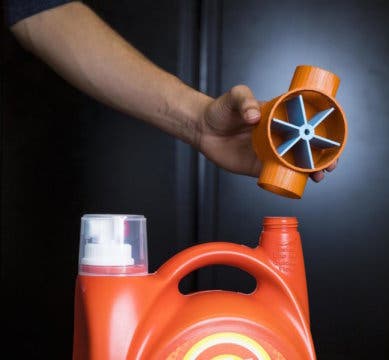People are turning more and more to “smart” technologies to do household tasks, such as using your phone to turn off lights or appliances remotely. Here is a first—a 3-D printed plastic object that has a sensor and can connect to WiFi- connected devices on its own. An interesting example is a detergent bottle which can detect when there only a little bit of detergent left and automatically order more on the internet.
But how can a lump of plastic, without any electronics, connect to WiFi? University of Washington researchers used backscatter techniques to let the devices exchange information. Backscatter technology usually uses an antenna to reflect radio signals that exchange information. The WiFi router can then decode these reflected signals. This 3-D printed object was able to communicate with a router through its own antenna made from plastic and copper.

Electrical components were replaced by purely mechanical components, such as springs, gears, and switches, so that they could be easily 3-D printed. The design was heavily inspired by battery-free watches. The design is also complete with a sensor. Motion on the sensor, such as the pouring out of detergent, triggers different gears and springs. The movement causes a conductive switch to send signals to the router. When a certain “low” point is reached, then the device communicates that it needs more detergent.
“As you pour detergent out of a Tide bottle, for instance, the speed at which the gears are turning tells you how much soap is flowing out. The interaction between the 3-D printed switch and antenna wirelessly transmits that data,” said senior author and Allen School associate professor Shyam Gollakota. “Then the receiver can track how much detergent you have left and when it dips below a certain amount, it can automatically send a message to your Amazon app to order more.”
The 3-D model instructions are being made available to the public, so that anyone with access to a 3-D printer can make these nifty gadgets that can communicate with other objects without wires or electronics. Other designs include a slider that controls music volume, a sensor that sends an alarm to your phone when there is a water leak, and a sensor that can detect low levels of flour or cereal and orders more. They operate with a flow meter, wind meter, or scale.
Though a device like this isn’t really necessary (you can see for yourself when the detergent is running low), the mechanism is quite interesting and could, perhaps, be used for other applications.


